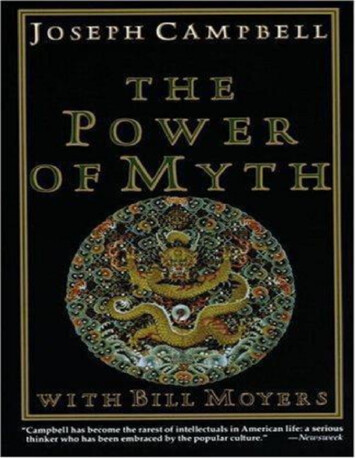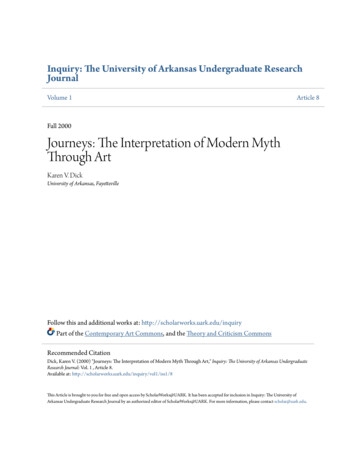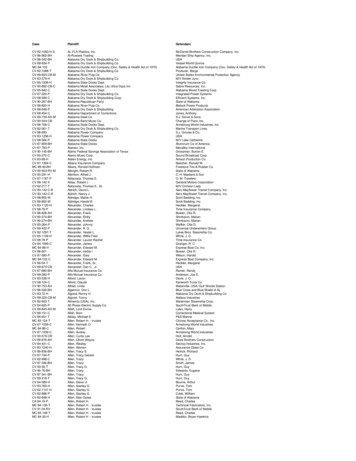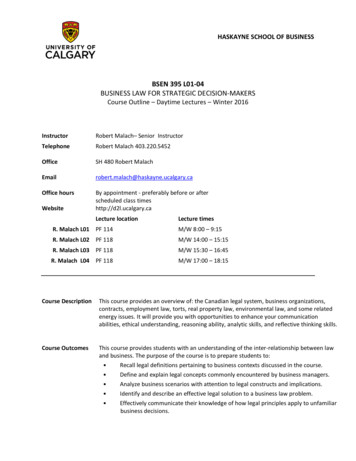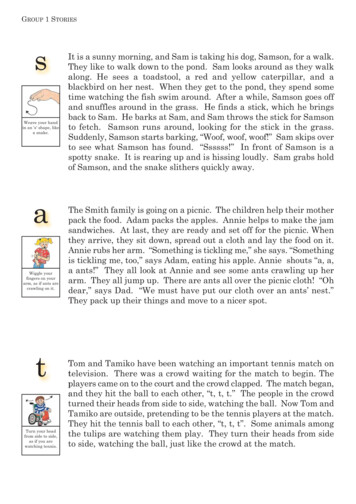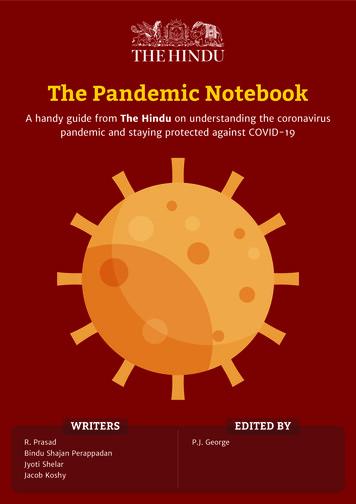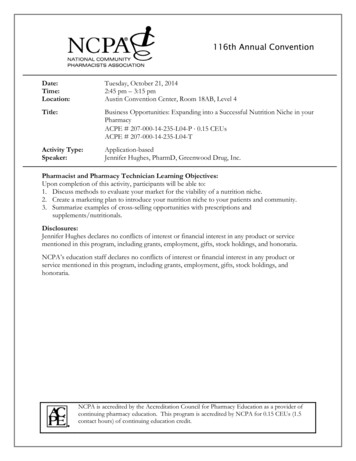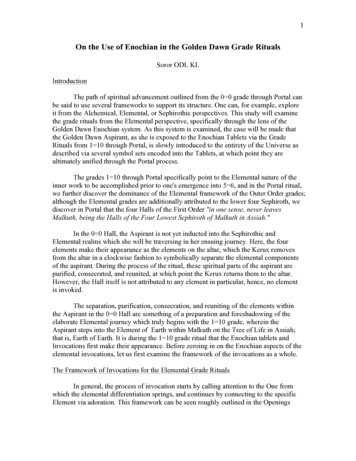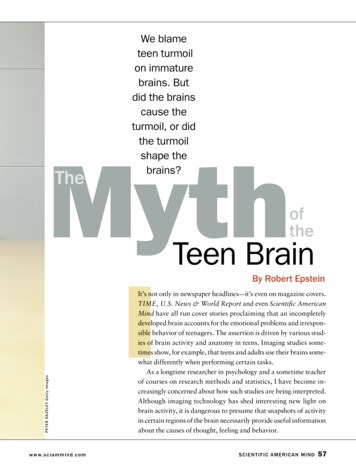
Transcription
We blameteen turmoilon immaturebrains. Butdid the brainscause theturmoil, or didthe turmoilshape thebrains?MythITheoftheTeen BrainP E T E R DA Z E L E Y G e t t y I m a g e sBy Robert Epsteinw w w. s c i a m m i n d .c o mIt’s not only in newspaper headlines— it’s even on magazine covers.TIME, U.S. News & World Report and even Scientific AmericanMind have all run cover stories proclaiming that an incompletelydeveloped brain accounts for the emotional problems and irresponsible behavior of teenagers. The assertion is driven by various studies of brain activity and anatomy in teens. Imaging studies sometimes show, for example, that teens and adults use their brains somewhat differently when performing certain tasks.As a longtime researcher in psychology and a sometime teacherof courses on research methods and statistics, I have become increasingly concerned about how such studies are being interpreted.Although imaging technology has shed interesting new light onbrain activity, it is dangerous to presume that snapshots of activityin certain regions of the brain necessarily provide useful informationabout the causes of thought, feeling and behavior.SCIENTIFIC AMERICAN MIND57
()If the “teen brain” were a universal phenomenon,we would find teen turmoil around the world.This fact is true in part because we know thatan individual’s genes and environmental history— and even his or her own behavior— mold thebrain over time. There is clear evidence that anyunique features that may exist in the brains ofteens — to the limited extent that such featuresexist— are the result of social influences ratherthan the cause of teen turmoil. As you will see, acareful look at relevant data shows that the teenbrain we read about in the headlines — the immature brain that supposedly causes teen problems — is nothing less than a myth.Cultural ConsiderationsThe teen brain fits conveniently into a largermyth, namely, that teens are inherently incompetent and irresponsible. Psychologist G. StanleyHall launched this myth in 1904 with the publication of his landmark two-volume book Adolescence. Hall was misled both by the turmoil ofhis times and by a popular theory from biologythat later proved faulty. He witnessed an exploding industrial revolution and massive immigration that put hundreds of thousands of youngFAST FACTSTroubled Teens1 Various imaging studies of brain activity and anatomyfind that teens and adults use their brains somewhatdifferently when performing certain tasks. These studies aresaid to support the idea that an immature “teen brain” accounts for teen mood and behavior problems.2 But, the author argues, snapshots of brain activity donot necessarily identify the causes of such problems.Culture, nutrition and even the teen’s own behavior all affectbrain development. A variety of research in several fields suggest that teen turmoil is caused by cultural factors, not by afaulty brain.3 Anthropological research reveals that teens in manycultures experience no turmoil whatsoever and thatteen problems begin to appear only after Western schooling,movies and television are introduced.4 Teens have the potential to perform in exemplary ways,the author says, but we hold them back by infantilizingthem and trapping them in the frivolous world of teen culture.58SCIENTIFIC AMERICAN MINDpeople onto the streets of America’s burgeoningcities. Hall never looked beyond those streets informulating his theories about teens, in part because he believed in “recapitulation”— a theoryfrom biology that asserted that individual development (ontogeny) mimicked evolutionary development (phylogeny). To Hall, adolescence wasthe necessary and inevitable reenactment of a“savage, pigmoid” stage of human evolution. Bythe 1930s the recapitulation theory was completely discredited in biology, but psychologistsand the general public never got the message.Many still believe, consistent with Hall’s assertion, that teen turmoil is an inevitable part ofhuman development.Today teens in the U.S. and some other Westernized nations do display some signs of distress.The peak age for arrest in the U.S. for most crimeshas long been 18; for some crimes, such as arson,the peak comes much earlier. On average, American parents and teens tend to be in conflict withone another 20 times a month— an extremely highfigure indicative of great pain on both sides. Anextensive study conducted in 2004 suggests that18 is the peak age for depression among people 18and older in this country. Drug use by teens, bothlegal and illegal, is clearly a problem here, andsuicide is the third leading cause of death amongU.S. teens. Prompted by a rash of deadly schoolshootings over the past decade, many Americanhigh schools now resemble prisons, with guards,metal detectors and video monitoring systems,and the high school dropout rate is nearly 50 percent among minorities in large U.S. cities.But are such problems truly inevitable? If theturmoil-generating “teen brain” were a universaldevelopmental phenomenon, we would presumably find turmoil of this kind around the world.Do we?In 1991 anthropologist Alice Schlegel of theUniversity of Arizona and psychologist HerbertBarry III of the University of Pittsburgh reviewedresearch on teens in 186 preindustrial societies.Among the important conclusions they drewabout these societies: about 60 percent had noword for “adolescence,” teens spent almostall their time with adults, teens showed almostno signs of psychopathology, and antisocialbehavior in young males was completelyabsent in more than half these cultures andA p r i l / M ay 2 0 07
C AT H E R I N E L E D N E R G e t t y I m a g e sextremely mild in cultures in which it did occur.Even more significant, a series of long-termstudies set in motion in the 1980s by anthropologists Beatrice Whiting and John Whiting of Harvard University suggests that teen trouble beginsto appear in other cultures soon after the introduction of certain Western influences, especiallyWestern-style schooling, television programs andmovies. Delinquency was not an issue among theInuit people of Victoria Island, Canada, for example, until TV arrived in 1980. By 1988 theInuit had created their first permanent police station to try to cope with the new problem.Consistent with these modern observations,many historians note that through most ofrecorded human history the teen years were arelatively peaceful time of transition to adulthood. Teens were not trying to break away fromadults; rather they were learning to becomeadults. Some historians, such as Hugh Cunningham of the University of Kent in England andMarc Kleijwegt of the University of Wisconsin–Madison, author of Ancient Youth: The Ambiguity of Youth and the Absence of Adolescencein Greco-Roman Society (J. C. Gieben, 1991),suggest that the tumultuous period we call ado-w w w. s c i a m m i n d .c o mlescence is a very recent phenomenon—not muchmore than a century old.My own recent research, viewed in combination with many other studies from anthropology,psychology, sociology, history and other disciplines, suggests the turmoil we see among teensin the U.S. is the result of what I call “artificialextension of childhood” past puberty. Over thepast century, we have increasingly infantilizedour young, treating older and older people as children while also isolating them from adults. Lawshave restricted their behavior [see box on nextpage]. Surveys I have conducted show that teensin the U.S. are subjected to more than 10 times asmany restrictions as are mainstream adults, twiceas many restrictions as active-duty U.S. Marines,and even twice as many restrictions as incarcerated felons. And research I conducted with DianeDumas as part of her dissertation research at theCalifornia School of Professional Psychologyshows a positive correlation between the extentto which teens are infantilized and the extent towhich they display signs of psychopathology.The headlines notwithstanding, there is noquestion that teen turbulence is not inevitable. Itis a creation of modern culture, pure and sim-In many Westerncultures, teenssocialize almostexclusively withother teens.SCIENTIFIC AMERICAN MIND59
two things. First, most of the brain changes thatare observed during the teen years lie on a continuum of changes that take place over much ofour lives. For example, a 1993 study by JésusPujol and his colleagues at the Autonomous University of Barcelona looked at changes in the corpus callosum— a massive structure that connectsthe two sides of the brain — over a two-year period with individuals between 11 and 61 yearsold. They found that although the rate of growthdeclined as people aged, this structure still grewby about 4 percent each year in people in their40s (compared with a growth rate of 29 percentin their youngest subjects). Other studies, conducted by researchers such as Elizabeth Sowell ofthe University of California, Los Angeles, showthat gray matter in the brain continues to disappear from childhood well into adulthood.Second, I have not been able to find evena single study that establishes a causal relationbetween the properties of the brain being examined and the problems we see in teens. By theirvery nature, imaging studies are correlational,showing simply that activity in the brain isassociated with certain behavior or emotion.As we learn in elementary statistics courses,ple — and so, it would appear, is the brain of thetroubled teen.Dissecting Brain StudiesA variety of recent research— most of it conducted using magnetic resonance imaging (MRI)technology— is said to show the existence of ateen brain. Studies by Beatriz Luna of the department of psychiatry at the University of Pittsburgh, for example, are said to show that teensuse prefrontal cortical resources differently thanadults do. Susan F. Tapert of the University ofCalifornia, San Diego, found that for certainmemory tasks, teens use smaller areas of the cortex than adults do. An electroencephalogram(EEG) study by Irwin Feinberg and his colleaguesat the University of California, Davis, shows thatdelta-wave activity during sleep declines in theearly teen years. Jay Giedd of the National Institute of Mental Health and other researchers suggest that the decline in delta-wave activity mightbe related to synaptic pruning— a reduction inthe number of interconnections among neurons — that occurs during the teen years.This work seems to support the idea of theteen brain we see in the headlines until we realizeU.S. teens have 10 times as many restrictions asadults, twice as many as active-duty U.S. marines and twice as many as incarcerated felons.Laws restricting the behavior of young people (under age 18) have grown rapidly in the past century,according to a survey by the author. He found that160Laws Restricting Teen Behavior140120100806040200 l l1700llll l1750llll l1800llll l1850llll l1900llll l1950llll2000Year60SCIENTIFIC AMERICAN MINDA p r i l / M ay 2 0 07S O U R C E : T H E C A S E A G A I N S T A D O L E S C E N C E , B Y R O B E R T E P S T E I N ( Q U I L L D R I V E R B O O K S , 2 0 07 )Rebels with a Cause
(Studies of intelligence, perception and memory showthat teens are in many ways superior to adults.)ERIK DREYER Getty ImagesYoung peoplehave extraordinarypotential thatis often notexpressedbecause teensare infantilizedand isolatedfrom adults.correlation does not even imply causation. In thatsense, no imaging study could possibly identifythe brain as a causal agent, no matter what areasof the brain were being observed.Is it ever legitimate to say that human behavior is caused by brain anatomy or activity? [See“Brain Scans Go Legal,” by Scott T. Grafton,Walter P. Sinnott-Armstrong, Suzanne I. Gazzaniga and Michael S. Gazzaniga; ScientificAmerican Mind, December 2006/January2007.] In his 1998 book Blaming the Brain, neuroscientist Elliot Valenstein deftly points out thatwe make a serious error of logic when we blamealmost any behavior on the brain — especiallywhen drawing conclusions from brain-scanningstudies. Without doubt, all behavior and emotionmust somehow be reflected (or “encoded”) inbrain structure and activity; if someone is impulsive or lethargic or depressed, for example, his orher brain must be wired to reflect those behaviors. But that wiring (speaking loosely) is not necessarily the cause of the behavior or emotion thatwe see.Considerable research shows that a person’semotions and behavior continuously change brainw w w. s c i a m m i n d .c o manatomy and physiology. Stress creates hypersensitivity in dopamine-producing neurons that persists even after they are removed from the brain.Enriched environments produce more neuronalconnections. For that matter, meditation, diet, exercise, studying and virtually all other activitiesalter the brain, and a new study shows that smoking produces brain changes similar to those produced in animals given heroin, cocaine or otheraddictive drugs. So if teens are in turmoil, we willnecessarily find some corresponding chemical,electrical or anatomical properties in the brain. Butdid the brain cause the turmoil, or did the turmoilalter the brain? Or did some other factors— such asthe way our culture treats its teens— cause both theturmoil and the corresponding brain properties?(The Author)ROBERT EPSTEIN is a contributing editor for Scientific American Mind andthe former editor in chief of Psychology Today. He received his Ph.D. inpsychology from Harvard University and is a longtime researcher andprofessor. His latest book is called The Case against Adolescence: Rediscovering the Adult in Every Teen (Quill Driver Books, 2007). More information is at www.thecaseagainstadolescence.com.SCIENTIFIC AMERICAN MIND61
Unfortunately, news reports— and even the researchers themselves — often get carried awaywhen interpreting brain studies. For instance, a2004 study conducted by James Bjork and his colleagues at the National Institute on Alcohol Abuseand Alcoholism, at Stanford University and at theCatholic University of America was said in variousmedia reports to have identified the biologicalroots of teen laziness. In the actual study, 12young people (ages 12 to 17) and 12 somewhatolder people (ages 22 to 28) were monitored withan MRI device while performing a simple taskthat could earn them money. They were told topress a button after a short anticipation period(about two seconds) following the brief display ofa symbol on a small mirror in front of their eyes.Some symbols indicated that pressing the buttonwould earn money, whereas others indicated that62SCIENTIFIC AMERICAN MINDfailing to respond would cost money. After theanticipation period, subjects had 0.25 second toreact, after which time information was displayedto let them know whether they had won or lost.Areas of the brain that are believed to be involved in motivation were scanned during thissession. Teens and adults were found to performequally well on the task, and brain activity differed somewhat in the two groups — at least during the anticipation period and when 5 (themaximum amount that could be earned) was onthe line. Specifically, on those high-payment trials the average activity of neurons in the rightnucleus accumbens — but not in other areas thatwere being monitored — was higher for adultsthan for teens. Because brain activity in the twogroups did not differ in other brain areas or under other payment conditions, the researchersdrew a very modest conclusion in their article:“These data indicate qualitative similarities overall in the brain regions recruited by incentive processing in healthy adolescents and adults.”But according to the Long Island, N.Y., newspaper Newsday, this study identified a “biologicalreason for teen laziness.” Even more disturbing,lead author James Bjork said that his study “tellsus that teenagers love stuff, but aren’t as willingto get off the couch to get it as adults are.”In fact, the study supports neither statement.If you truly wanted to know something about thebrains of lazy teens, at the very least you wouldhave to have some lazy teens in your study. Nonewere identified as such in the Bjork study. Thenyou would have to compare the brains of thoseteens with the brains of industrious teens, as wellA p r i l / M ay 2 0 07A N D R E W R U L L S TA D T h e A m e s Tr i b u n e / A P P h o t o ( t o p ) ; B I L L P U G L I A N O G e t t y I m a g e s N e w s ( b o t t o m )Elected achievers:Sam Juhl, 18,mayor of Roland,Iowa and MichaelSessions, now 19,mayor of Hillsdale, Mich.
as with the brains of both lazy and industriousadults. Most likely, you would then end up finding out how, on average, the brains in these fourgroups differed from one another. But even thistype of analysis would not allow you to concludethat some teens are lazy “because” they havefaulty brains. To find out why certain teens orcertain adults are lazy (and, perforce, why theyhave brains that reflect their lazy tendencies), youwould still have to look at genetic and environmental factors. A brain-scanning study can shedno light.Valenstein blames the pharmaceutical industry for setting the stage for overinterpreting theresults of brain studies such as Bjork’s. The drugcompanies have a strong incentive to convincepublic policymakers, researchers, media professionals and the general public that faulty brainsunderlie all our problems — and, of course, thatent kinds of intelligence tests, each showed thatraw scores on intelligence tests peak betweenages 13 and 15 and decline after that throughoutlife. Although verbal expertise and some formsof judgment can remain strong throughout life,the extraordinary cognitive abilities of teens, andespecially their ability to learn new things rapidly, is beyond question. And whereas brain sizeis not necessarily a good indication of processingability, it is notable that recent scanning data collected by Eric Courchesne and his colleagues atthe University of California, San Diego, showthat brain volume peaks at about age 14. By thetime we are 70 years old, our brain has shrunk tothe size it had been when we were about three.Findings of this kind make ample sense whenyou think about teenagers from an evolutionaryperspective. Mammals bear their young shortlyafter puberty, and until very recently so have()When we treat teens like adults, they almost immediatelyrise to the challenge.pharmaceuticals can fix those problems. Researchers, in turn, have a strong incentive to convince the public and various funding agenciesthat their research helps to “explain” importantsocial phenomena.The Truth about TeensIf teen chaos is not inevitable, and if such difficulty cannot legitimately be blamed on a faultybrain, just what is the truth about teens? Thetruth is that they are extraordinarily competent,even if they do not normally express that competence. Research I conducted with Dumas shows,for example, that teens are as competent or virtually as competent as adults across a wide range ofadult abilities. And long-standing studies of intelligence, perceptual abilities and memory function show that teens are in many instances farsuperior to adults.Visual acuity, for example, peaks around thetime of puberty. “Incidental memory”— the kindof memory that occurs automatically, withoutany mnemonic effort, peaks at about age 12 anddeclines through life. By the time we are in our60s, we remember relatively little “incidentally,”which is one reason many older people have trouble mastering new technologies. In the 1940spioneering intelligence researchers J. C. Ravenand David Wechsler, relying on radically differ-w w w. s c i a m m i n d .c o mmembers of our species, Homo sapiens. No matter how they appear or perform, teens must beincredibly capable, or it is doubtful the humanrace could even exist.Today, with teens trapped in the frivolousworld of peer culture, they learn virtually everything they know from one another rather thanfrom the people they are about to become. Isolatedfrom adults and wrongly treated like children, it isno wonder that some teens behave, by adult standards, recklessly or irresponsibly. Almost withoutexception, the reckless and irresponsible behaviorwe see is the teen’s way of declaring his or heradulthood or, through pregnancy or the commission of serious crime, of instantly becoming anadult under the law. Fortunately, we also knowfrom extensive research both in the U.S. and elsewhere that when we treat teens like adults, theyalmost immediately rise to the challenge.We need to replace the myth of the immatureteen brain with a frank look at capable and savvyteens in history, at teens in other cultures and atthe truly extraordinary potential of our ownyoung people today. M(Further Reading) Blaming the Brain: The Truth about Drugs and Mental Health. Elliot S.Valenstein. Free Press, 1998. The End of Adolescence. Philip Graham. Oxford University Press, 2004.SCIENTIFIC AMERICAN MIND63
58 SCIENTIFIC AMERICAN MIND April/May 2007 This fact is true in part because we know that an individual’s genes and environmental histo-ry—and even his or her own behavior—mold the brain over time. There is clear evidence that any unique features that may exist in the
